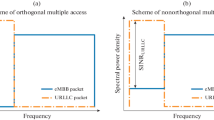Abstract
In the paper, we study the problem of multiplexing Ultra-Reliable Low-Latency Communications (URLLC) and enhanced Mobile Broadband (eMBB) traffic in the downlink channel of 5G systems. The Multi-User Multiple Input Multiple Output (MU-MIMO) technology is used for multiplexing, which allows a base station to transmit data simultaneously to several users in the same time–frequency resources. We propose a new algorithm (scheduler) that allocates time–frequency resources and transmission parameters for eMBB and URLLC users and dynamically distributes the base station transmission power between users. Simulation shows that the proposed scheduler increases the coverage for URLLC users and the throughput for eMBB users compared with the existing schedulers.



Similar content being viewed by others
REFERENCES
“Framework and overall objectives of the future development of IMT for 2020 and beyond,” ITU-R. Recommendation M.2083 (2015).
W. Yang, C. P. Li, A. Fakoorian, K. Hosseini, and W. Chen, “Dynamic URLLC and eMBB multiplexing design in 5G new radio,” in Proc. IEEE 17th Annual Consumer Communications Networking Conf. (CCNC), 2020 (IEEE, New York, 2020), pp. 1–5.
A. A. Esswie and K. I. Pedersen, “Null space based preemptive scheduling for joint URLLC and eMBB traffic in 5G networks,” in IEEE Globecom Workshops (GC Wkshps), Abu Dhabi, Dec. 9–13, 2018 (IEEE, New York, 2018), p. 1–6.
A. A. Esswie and K. I. Pedersen, “Opportunistic spatial preemptive scheduling for URLLC and eMBB coexistence in multi-user 5G networks,” IEEE Access. 6, 38451–38463 (2018).
A. A. Esswie and K. I. Pedersen, “Multi-user preemptive scheduling for critical low latency communications in 5G networks,” in IEEE Symp. on Computers and Commun. (ISCC),Natal, Brazil, June 25—28, 2018 (IEEE, New York, 2018), pp. 136–141.
A. Karamyshev, E. Khorov, A. Krasilov, and I. F. Akyildiz, “Fast and accurate analytical tools to estimate network capacity for URLLC in 5G systems,” Comput. Networks 178, (2020).
E. Khorov, A. Krasilov, I. Selnitskiy, and I. F. Akyildiz, “A framework to maximize the capacity of 5G systems for ultra-reliable low-latency communications,” IEEE Trans. on Mobile Comput. 20, 2111–2123 (2021).
E. Khorov, A. Krasilov, and A. Malyshev, “Radio resource and traffic management for ultra-reliable low latency communications,” in IEEE Wireless Commun. & Networking Conf. (WCNC), Barselona, Spain, Apr. 15–18, 2018, (IEEE, New York, 2018), pp. 1– 6.
C. Lu, W. Wang, W. Zhong, and X. Gao, “User scheduling and beam allocation for massive MIMO systems with two-stage precoding,” in IEEE 27th Annual Int. Symp. on Personal, Indoor, and Mobile Radio Commun. (PIMRC), Valencia, Spain, Sept. 4–8, 2016 (IEEE, New York, 2018), pp. 1– 6.
R. Kwan, C. Leung, and J. Zhang, “Proportional Fair Multiuser Scheduling in LTE,” IEEE Signal Process. Lett. 16, 461–464 (2009).
T. Yoo and A. Goldsmith, “On the optimality of multiantenna broadcast scheduling using zero-forcing beamforming,” IEEE J. on Selected Areas in Commun. 24, 528–541 (2006).
A. Duran, M. Toril, F. Ruiz, and A. Mendo, “Self-optimization algorithm for outer loop link adaptation in LTE,” IEEE Commun. Lett. 19, 2005–2008 (2015).
A. Belogaev, E. Khorov, A. Krasilov, D. Shmelkin, and S. Tang, “Conservative link adaptation for ultra reliable low latency communications,” IEEE BlackSeaCom, 1–5 (2019).
A. Krasilov, I. Lebedeva, R. Yusupov, and E. Khorov, “Efficient multiplexing of downlink eMBB and URLLC traffic with massive MU-MIMO,” IEEE BlackSeaCom, 1–6 (2022).
“Network Simulator 3” [Online]. Available: https://www.nsnam.org/.
Funding
The work was carried out at the National Research University Higher School of Economics and supported by the Russian Science Foundation grant no. 21-79-10158, https://rscf.ru/en/project/21-79-10158/.
Author information
Authors and Affiliations
Corresponding authors
Ethics declarations
The authors declare that they have no conflicts of interest.
Additional information
Translated by M. Chubarova
Rights and permissions
About this article
Cite this article
Lebedeva, I.V., Yusupov, R.R., Krasilov, A.N. et al. Multiplexing of URLLC and eMBB Traffic in a Downlink Channel with MU-MIMO. J. Commun. Technol. Electron. 67, 1506–1512 (2022). https://doi.org/10.1134/S1064226922120129
Received:
Revised:
Accepted:
Published:
Issue Date:
DOI: https://doi.org/10.1134/S1064226922120129




